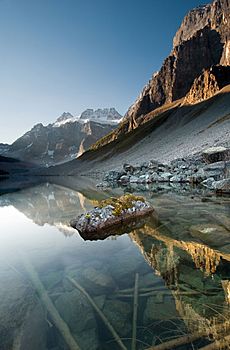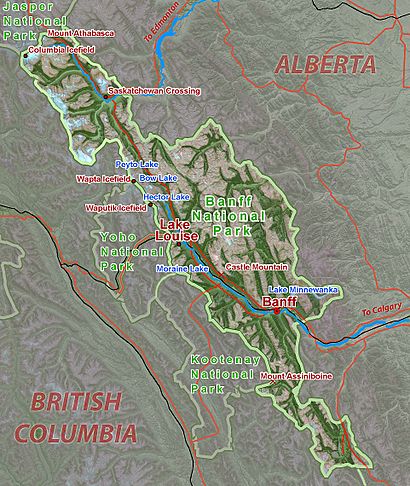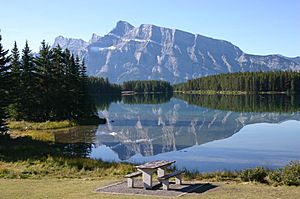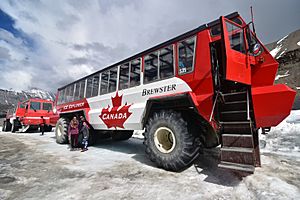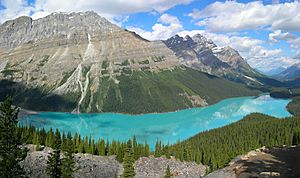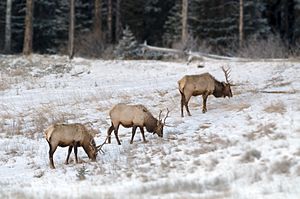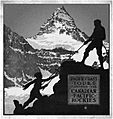Banff National Park facts for kids
Quick facts for kids Banff National Park |
|
|---|---|
|
IUCN Category II (National Park)
|
|

Moraine Lake, and the Valley of the Ten Peaks
|
|
| Location | Alberta |
| Nearest town | Canmore, Alberta |
| Area | 6,641 km2 (2,564 sq mi) |
| Established | 1885 |
| Visitors | 3,609,639 (in 2014/15) |
| Governing body | Parks Canada |
Banff National Park (French: Parc national Banff) is Canada's oldest national park and was established in 1885. Located in Alberta's Rocky Mountains, 110–180 kilometres (68–112 mi) west of Calgary, Banff encompasses 6,641 square kilometres (2,564 sq mi) of mountainous terrain, with many glaciers and ice fields, dense coniferous forest, and alpine landscapes. The Icefields Parkway extends from Lake Louise, connecting to Jasper National Park in the north. Provincial forests and Yoho National Park are neighbours to the west, while Kootenay National Park is located to the south and Kananaskis Country to the southeast. The main commercial centre of the park is the town of Banff, in the Bow River valley.
The Canadian Pacific Railway was instrumental in Banff's early years, building the Banff Springs Hotel and Chateau Lake Louise, and attracting tourists through extensive advertising. In the early 20th century, roads were built in Banff, at times by war internees from World War I, and through Great Depression-era public works projects. Since the 1960s, park accommodations have been open all year, with annual tourism visits to Banff increasing to over 5 million in the 1990s. Millions more pass through the park on the Trans-Canada Highway. As Banff has over three million visitors annually, the health of its ecosystem has been threatened. In the mid-1990s, Parks Canada responded by initiating a two-year study which resulted in management recommendations and new policies that aim to preserve ecological integrity.
Banff National Park has a subarctic climate with three ecoregions, including montane, subalpine, and alpine. The forests are dominated by Lodgepole pine at lower elevations and Engelmann spruce in higher ones below the treeline, above which is primarily rocks and ice. Mammal species such as the grizzly bear, cougar, wolverine, elk, bighorn sheep and moose are found, along with hundreds of bird species. Reptiles and amphibians are also found but only a limited number of species have been recorded. The mountains are formed from sedimentary rocks which were pushed east over newer rock strata, between 80 and 55 million years ago. Over the past few million years, glaciers have at times covered most of the park, but today are found only on the mountain slopes though they include the Columbia Icefield, the largest uninterrupted glacial mass in the Rockies. Erosion from water and ice have carved the mountains into their current shapes.
Contents
Geography
Banff National Park is located in the Rocky Mountains on Alberta's western border with British Columbia in the Alberta Mountain forests ecoregion. By road, the town of Banff is 128 kilometres (80 mi) west of Calgary and 401 km (249 mi) southwest of Edmonton. Jasper National Park borders Banff National Park to the north, while Yoho National Park is to the west and Kootenay National Park is to the south. Kananaskis Country, which includes Bow Valley Wildland Provincial Park, Spray Valley Provincial Park, and Peter Lougheed Provincial Park, is located to the south and east of Banff. The Trans-Canada Highway passes through Banff National Park, from the eastern boundary near Canmore, through the towns of Banff and Lake Louise, and into Yoho National Park in British Columbia. The Banff townsite is the main commercial centre in the national park. The village of Lake Louise is located at the junction of the Trans-Canada Highway and the Icefields Parkway, which extends north to the Jasper townsite.
Banff
Banff, established in 1885, is the main commercial centre in Banff National Park, as well as a centre for cultural activities. Banff is home to several cultural institutions, including the Banff Centre, the Whyte Museum, the Buffalo Nations Luxton Museum, Cave and Basin National Historic Site, and several art galleries. Throughout its history, Banff has hosted many annual events, including Banff Indian Days which began in 1889, and the Banff Winter Carnival. Since 1976, The Banff Centre has organized the Banff Mountain Film Festival. In 1990, Banff incorporated as a town of Alberta, though still subject to the National Parks Act and federal authority in regards to planning and development. In its 2014 census, the town of Banff had a permanent population of 8,421 as well as 965 non-permanent residents for a total population of 9,386. The Bow River flows through the town of Banff, with the Bow Falls located on the outskirts of town.
Lake Louise
Lake Louise, a hamlet located 54 km (34 mi) northwest of the town of Banff, is home to the landmark Chateau Lake Louise at the edge of Lake Louise. Located 15 km (9.3 mi) from Lake Louise, Moraine Lake provides a scenic vista of the Valley of the Ten Peaks. This scene was pictured on the back of the $20 Canadian banknote, in the 1969–1979 ("Scenes of Canada") series. The Lake Louise Mountain Resort is also located near the village. Lake Louise is one of the most visited lakes in the world and is framed to the southwest by the Mount Victoria Glacier.
Icefields Parkway
The Icefields Parkway is a 230-kilometre-long (140 mi) road connecting Lake Louise to Jasper, Alberta. The Parkway originates at Lake Louise, and extends north up the Bow Valley, past Hector Lake, which is the largest natural lake in the park. Other scenic lakes near the parkway include Bow Lake, and Peyto Lakes, both north of Hector Lake. The Parkway then crosses Bow Summit (2,088 m (6,850 ft)), and follows the Mistaya River to Saskatchewan Crossing, where it converges with the Howse and North Saskatchewan River. Bow Summit is the highest elevation crossed by a public road in Canada.
The North Saskatchewan River flows east from Saskatchewan Crossing, out of Banff, into what is known as David Thompson Country, and onto Edmonton. The David Thompson Highway follows the North Saskatchewan River, past the man-made Abraham Lake, and through David Thompson Country.
North of Saskatchewan Crossing, the Icefields Parkway follows the North Saskatchewan River up to the Columbia Icefield. The Parkway crosses into Jasper National Park at Sunwapta Pass at 2,035 metres (6,677 ft) in elevation, and continues on from there to the Jasper townsite.
Geology
The Canadian Rockies consist of several northwest-southeast trending ranges. Two main mountain ranges are within the park, each consisting of numerous subranges. The western border of the park follows the crest of the Main Ranges (also known as the Park Ranges), which is also the continental divide. The Main Ranges in Banff National Park include from north to south, the Waputik, Bow and Blue Ranges. The high peaks west of Lake Louise are part of the Bow Range. The eastern border of the park includes all of the Front Ranges consisting of from north to south, the Palliser, Sawback and Sundance Ranges. The Banff townsite is located in the Front Ranges. Just outside of the park to the east lie the foothills that extend from Canmore at the eastern entrance of the park eastward into the Great Plains. Well west of the park, the Western Ranges of the Rockies pass through Yoho and Kootenay National Parks. Though the tallest peak entirely within the park is Mount Forbes at 3,612 metres (11,850 ft), Mount Assiniboine on the Banff-Mount Assiniboine Provincial Park border is slightly higher at 3,618 m (11,870 ft).
The Canadian Rockies are composed of sedimentary rock, including shale, sandstone, dolomite and limestone. The vast majority of geologic formations in Banff range in age from Precambrian to the Jurassic periods (600–145 m.y.a.). However, rocks as young as the lower Cretaceous (145–66 m.y.a.) can be found near the east entrance and on Cascade Mountain above the Banff townsite. These sedimentary rocks were laid down in shallow seas between 600 and 175 m.y.a. and were pushed east during the Laramide orogeny. Mountain building in Banff National Park ended approximately 55 m.y.a.
The Canadian Rockies may have rose up to 8,000 metres (26,000 ft) approximately 70 m.y.a. Once mountain formation ceased, erosion carved the mountains into their present rugged shape. The erosion was first due to water, then was greatly accelerated by the Quaternary glaciation 2.5 million years ago. Glacial landforms dominate Banff's geomorphology, with examples of all classic glacial forms, including cirques, arêtes, hanging valleys, moraines, and U-shaped valleys. The pre-existing structure left over from mountain-building strongly guided glacial erosion: mountains in Banff include complex, irregular, anticlinal, synclinal, castellate, dogtooth, and sawback mountains.
Many of the mountain ranges trend northwest to southeast, with sedimentary layering dipping down to the west at 40–60 degrees. This leads to dip slope landforms, with generally steeper east and north faces, and trellis drainage, where rivers and old glacial valleys followed the weaker layers in the rocks as they were relatively easily weathered and eroded. Classic examples are found at the Banff townsite proper: Mount Rundle is a classic dip slope mountain. Just to the north of the Banff townsite, Castle Mountain is composed of numerous Cambrian age rock formations. The uppermost section of the peak consists of relatively harder dolomite from the Eldon Formation. Below that lies the less dense shales of the Stephen Formation and the lowest exposed cliffs are limestones of the Cathedral Formation. Dogtooth mountains, such as Mount Louis, exhibit sharp, jagged slopes. The Sawback Range, which consists of nearly vertical dipping sedimentary layers, has been eroded by cross gullies. The erosion of these almost vertical layers of rock strata in the Sawback Range has resulted in formations that appear like the teeth on a saw blade. Erosion and deposition of higher elevation rock layers has resulted in scree deposits at the lowest elevations of many of the mountains.
Glaciers and icefields
Banff National Park has numerous large glaciers and icefields, 100 of which can be observed from the Icefields Parkway. Small cirque glaciers are fairly common in the Main Ranges, situated in depressions on the side of many mountains. As with the majority of mountain glaciers around the world, the glaciers in Banff are retreating. While Peyto Glacier is one of the longest continuously studied glaciers in the world, with research extending back to the 1970s, most of the glaciers of the Canadian Rockies have only been scientifically evaluated since the late 1990s. Glaciologists are now researching the glaciers in the park more thoroughly, and have been analyzing the impact that reduced glacier ice may have on water supplies to streams and rivers. Estimates are that 150 glaciers disappeared in the Canadian Rockies (areas both inside and outside Banff National Park) between the years 1920 and 1985. Another 150 glaciers disappeared between 1985 and 2005, indicating that the retreat and disappearance of glaciers is accelerating. In Banff National Park alone, in 1985 there were 365 glaciers but by 2005, 29 glaciers had disappeared. The total glaciated area dropped from 625 to 500 square kilometres (241 to 193 sq mi) in that time period.
The largest glaciated areas include the Waputik and Wapta Icefields, which both lie on the Banff-Yoho National Park border. Wapta Icefield covers approximately 80 km2 (31 sq mi) in area. Outlets of Wapta Icefield on the Banff side of the continental divide include Peyto, Bow, and Vulture Glaciers. Bow Glacier retreated an estimated 1,100 m (3,600 ft) between the years 1850 and 1953, and since that period, there has been further retreat which has left a newly formed lake at the terminal moraine. Peyto Glacier has lost 70 percent of its volume since record keeping began and has retreated approximately 2,000 m (6,600 ft) since 1880; the glacier is at risk of disappearing entirely within the next 30 to 40 years.
The Columbia Icefield, at the northern end of Banff, straddles the Banff and Jasper National Park border and extends into British Columbia. Snow Dome, in the Columbia Icefield is a hydrological apex of North America, with water flowing via outlet glaciers to the Atlantic, Pacific and Arctic Oceans. Saskatchewan Glacier, which is approximately 13 km (8 mi) in length and 30 km2 (12 sq mi) in area, is the major outlet of the Columbia Icefield that flows into Banff National Park. Between the years 1893 and 1953, Saskatchewan Glacier had retreated a distance of 1,364 m (4,475 ft), with the rate of retreat between the years 1948 and 1953 averaging 55 m (180 ft) per year. Overall, the glaciers of the Canadian Rockies lost 25 percent of their mass during the 20th century.
Ecology
Ecoregions
Banff National Park spans three ecoregions, including montane, subalpine, and alpine. The subalpine ecoregion, which consists mainly of dense forest, comprises 53 percent of Banff's area. 27 percent of the park is located above the tree line, in the alpine ecoregion. The tree line in Banff lies approximately at 2,300 m (7,500 ft), with open meadows at alpine regions and some areas covered by glaciers. A small portion (3 percent) of the park, located at lower elevations, is in the montane ecoregion. Lodgepole pine forests dominate the montane region of Banff, with Engelmann spruce, willow, aspen, occasional Douglas-fir and a few Douglas maple interspersed. Engelmann spruce are more common in the subalpine regions of Banff, with some areas of lodgepole pine, and subalpine fir. The montane areas in the Bow Valley, which tend to be the preferred habitat for wildlife, have been subjected to significant human development over the years.
Wildlife
The park has 56 recorded mammal species. Grizzly bears and black bears inhabit the forested regions. Cougar, lynx, wolverine, red fox, weasel, river otter, coyote, and wolf are the primary predatory mammals. Elk, mule deer, and white-tailed deer are common in the valleys of the park, including around (and sometimes in) the Banff townsite, while moose tend to be more elusive, sticking primarily to wetland areas and near streams. In the alpine regions, mountain goat, bighorn sheep, marmot and pika are widespread. Other mammals such as beaver, porcupine, squirrel, chipmunk, snowshoe hare, and Columbian ground squirrel are the more commonly observed smaller mammals. Caribou were the rarest large mammals in the park, but an avalanche in 2009 may have killed the last five remaining within park boundaries.
Due to the harsh winters, the park has few reptile and amphibian species with only one species of toad, three species of frog, one salamander species and two species of snakes that have been identified. At least 280 species of birds can be found in Banff including bald and golden eagles, red-tailed hawk, osprey, and merlin, all of which are predatory species. Additionally, commonly seen species such as the Canada jay, American three-toed woodpecker, mountain bluebird, Clark's nutcracker, mountain chickadee and pipit are frequently found in the lower elevations. The white-tailed ptarmigan is a ground bird that is often seen in the alpine zones. Rivers and lakes are frequented by over a hundred different species including loon, heron and mallard which spend their summers in the park.
Endangered species in Banff include the Banff Springs snail (Physella johnsoni) that is found in the hot springs of Banff, and the Woodland caribou.
Mountain pine beetles
Mountain pine beetles have caused a number of large-scale infestations in Banff National Park, feeding on the phloem of mature lodgepole pines. Alberta's first known outbreak occurred in 1940, infecting 43 km2 (17 sq mi) of forest in Banff. A second major outbreak occurred in the late 1970s and early 1980s in Banff and the surrounding Rocky Mountains region.
Images for kids
-
View from the summit of Sulphur Mountain, showing Banff and the surrounding areas
-
Banff Springs Hotel, 1902
-
Canadian Pacific Railway advertising brochure, highlighting Mount Assiniboine and Banff scenery, c. 1917
-
Castle Mountain internment camp, 1915
-
the Columbia Icefield's Athabasca Glacier at the northern end of Banff
-
Parker Ridge, near the Columbia Icefield
-
Wildlife overpass
See also
 In Spanish: Parque nacional Banff para niños
In Spanish: Parque nacional Banff para niños


